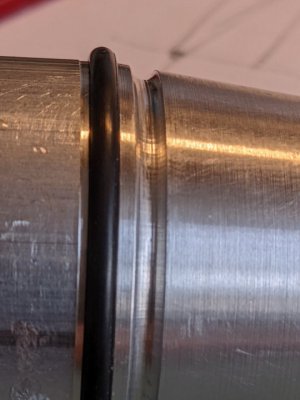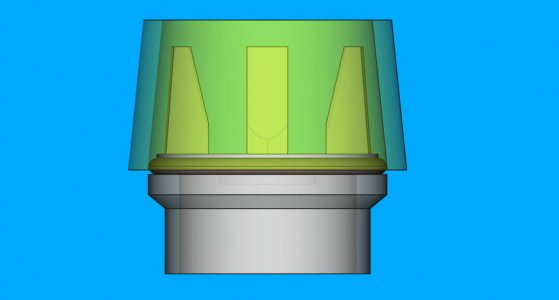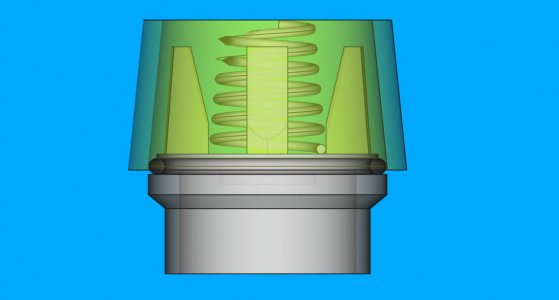-
Welcome back Guest! Did you know you can mentor other members here at H-M? If not, please check out our Relaunch of Hobby Machinist Mentoring Program!
You are using an out of date browser. It may not display this or other websites correctly.
You should upgrade or use an alternative browser.
You should upgrade or use an alternative browser.
Models for grinding HSS Lathe Tools
- Thread starter mikey
- Start date
- Joined
- Dec 18, 2019
- Messages
- 6,478
Doesn't seem to be a skill that I have at the moment. Not for a lack of trying. But need to move on.Order some fine belts and be done with honing. Not worth your aggravation.
Red Label Abrasives has a fine ceramic grit belt assortment that I will get. [P180, P240, P320 & P400] Should be fine for what I do.
For what it is worth, the tool bit cut ok with some expected chatter on my 6061 test piece on my mini-lathe. I hand turned the chuck for the last 0.010" depth at 0.001" depth steps and the finish came out chatter-free enough. I can still see it, but I believe the o-ring should seal on that. The surface where the 124 o-ring is now, is much better than the one on the right. Looks like I should have cut deeper, if I look at the o-ring. (Maybe even wider as well.)
The real workpiece is on my G0752Z, waiting for this bit. The valve design doesn't look like this and has more support for the o-ring on the left side. Just playing around a bit so that I can learn on a non-critical piece.

- Joined
- Jan 29, 2017
- Messages
- 311
Oring grooves should have a flat bottom with radii in the corners, so the material can be compressed slightly and has space to move in.
Whats wrong with a 2mm parting blade for grooving?
Whats wrong with a 2mm parting blade for grooving?
- Joined
- Dec 18, 2019
- Messages
- 6,478
Not disagreeing with you at all.Oring grooves should have a flat bottom with radii in the corners, so the material can be compressed slightly and has space to move in.
Whats wrong with a 2mm parting blade for grooving?
The o-ring is not seated against a right cylindrical wall surrounding the piston. The piston and o-ring seal against a tapered conical surface. Sort of like this picture. I have no idea why the valve is designed this way, but I merely want to copy the piston warts and all. The valve is designed to prevent outside contaminated water from entering the indoor potable water system. Rather copy it than become creative, for this one part.

Kind of a quick and dirty addition of the conical seat for the o-ring.
- Joined
- Jan 29, 2017
- Messages
- 311
Is it a static seal that the top bit sits on top of?
- Joined
- Jan 29, 2017
- Messages
- 311
Thr reason I ask is because it takes a reasonable amount of effort to compress an oring to create a seal thats watertight.
If something is just seated atop an oring there is no guarantee of a seal occurring.
If something is just seated atop an oring there is no guarantee of a seal occurring.
- Joined
- Dec 18, 2019
- Messages
- 6,478
The piston is forced upwards by the water pressure, about 45 pounds/square inch to seal the o-ring. This is part of a commercial and approved backflow prevention valve, pretty sure it has been engineered correctly. There is about a 5 pound spring (wild guess) that pops the valve open if indoor water pressure is lost. This is supposed to prevent irrigation water from re-entering the potable water system. Which is why I am copying it, rather than changing it.Thr reason I ask is because it takes a reasonable amount of effort to compress an oring to create a seal thats watertight.
If something is just seated atop an oring there is no guarantee of a seal occurring.
Here is a rough rendering of the spring pushing down the piston face. Think it is tapered this way.

Last edited:
- Joined
- Jan 29, 2017
- Messages
- 311
Gotcha, in other words it is a one way check valve in hydraulic terms.
- Joined
- Dec 18, 2019
- Messages
- 6,478
Exactly!Gotcha, in other words it is a one way check valve in hydraulic terms.
- Joined
- Oct 31, 2016
- Messages
- 2,649
Going to be machining some bearings out of delrin for a friend. The bearing are around 2.375 OD and 1.911 ID. 1.25" long. I will be rechecking all of my measurements this weekend. The bearings are for a rudder shaft on a Santa Cruz 27 sailboat. I have never worked with delrin before.
I will be starting with 2.5 OD 4" long rod held in a 3 jaw chuck. Plan to turn the OD first and then bore the ID. I could do it the other way too. ID first then OD. Makes no difference to me. I would like to bore all the way through. That way I can test fit the bearing on the shaft without removing the bearings from the chuck
Looking for suggestions on clearance and rake angles and speeds and feeds.
I will be starting with 2.5 OD 4" long rod held in a 3 jaw chuck. Plan to turn the OD first and then bore the ID. I could do it the other way too. ID first then OD. Makes no difference to me. I would like to bore all the way through. That way I can test fit the bearing on the shaft without removing the bearings from the chuck
Looking for suggestions on clearance and rake angles and speeds and feeds.

